
It’s one thing to build backlinks.
It’s another thing to determine how long before those backlinks take effect.
Link building is a waiting game. Anyone who builds backlinks for a living asks the same exact question.
Same goes for anyone who outsources link building for SEO and link building services.
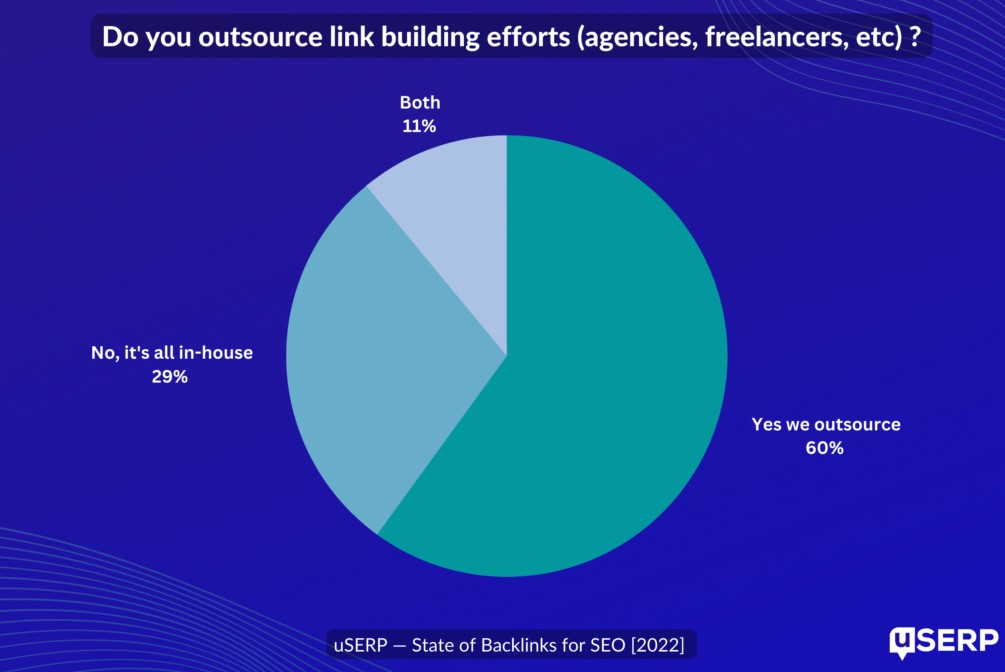
That question is, How long does link building take to influence rankings?
While there’s not one definitive answer, it’s good to have a general idea of how long it takes for backlinks to take effect.
For one thing, you’ll know what to expect. You won’t be sitting around waiting day after day.
How Long Does It Take for Backlinks to Take Effect?
In 2014, Matt Cutts of Google’s web spam team made a bold statement about backlinks becoming a “little less important” in the future. Apparently, that future hasn’t arrived yet.
Backlinks are and always have been Google’s most important ranking factor.
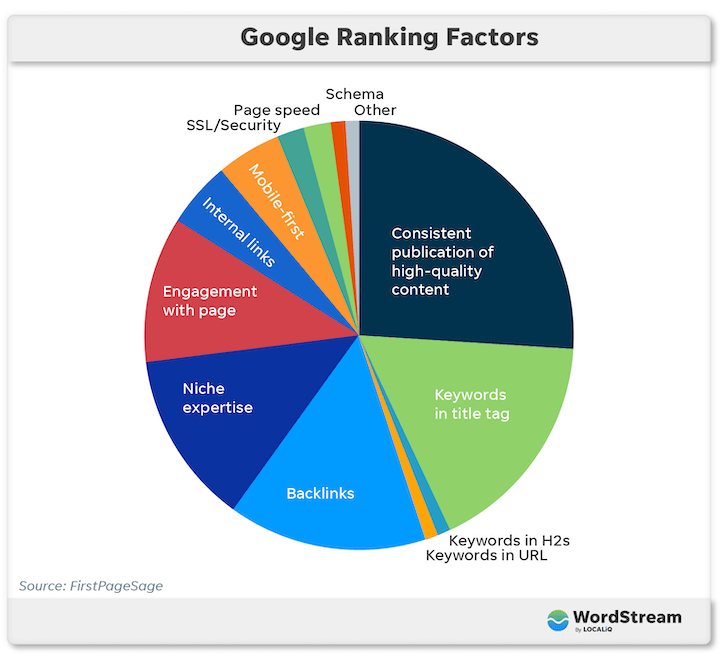
Brian Dean of Backlinko went so far as to analyze over one million Google search results. He came to the same conclusion: The number of backlinks to a page is correlated to its search engine ranking.
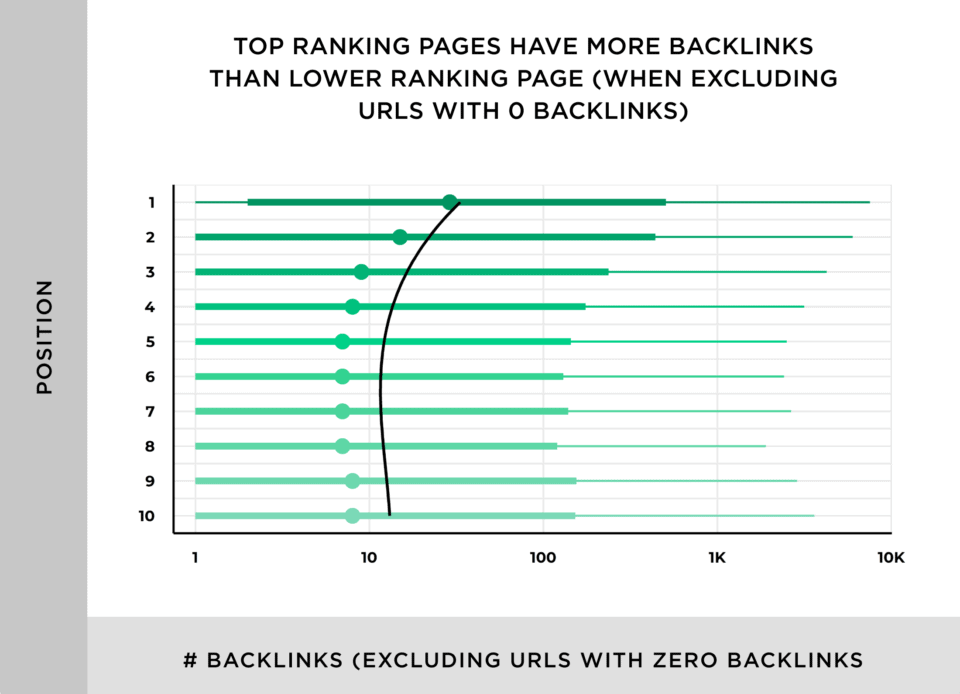
But backlinks alone won’t skyrocket a page to the top. There are many factors at play in search engine rankings.
And there are many things happening from the time a new backlink is acquired to the moment it starts influencing page rank.
Several SEO industry studies point out that relevant and comprehensive content, mobile optimization and a few technical factors also greatly influence how fast a page ranks on Google.
The effects of these other ranking factors make it doubly hard to set a definite timeline in which backlinks are guaranteed to produce results.
All you can do is set expectations. That’s what we intend to do here.
3 Phases of Backlinks: Indexing, Big Jump, Uphill Climb
Backlinks and the pages they’re pointing to usually undergo three phases: Indexing, the “Big Jump,” and the “Uphill Climb.”
Indexing
Indexing happens when Google picks up the page containing the backlink and includes it in its directory. You know the referring page has been indexed when you type in site: [URL] and Google displays it in the results.
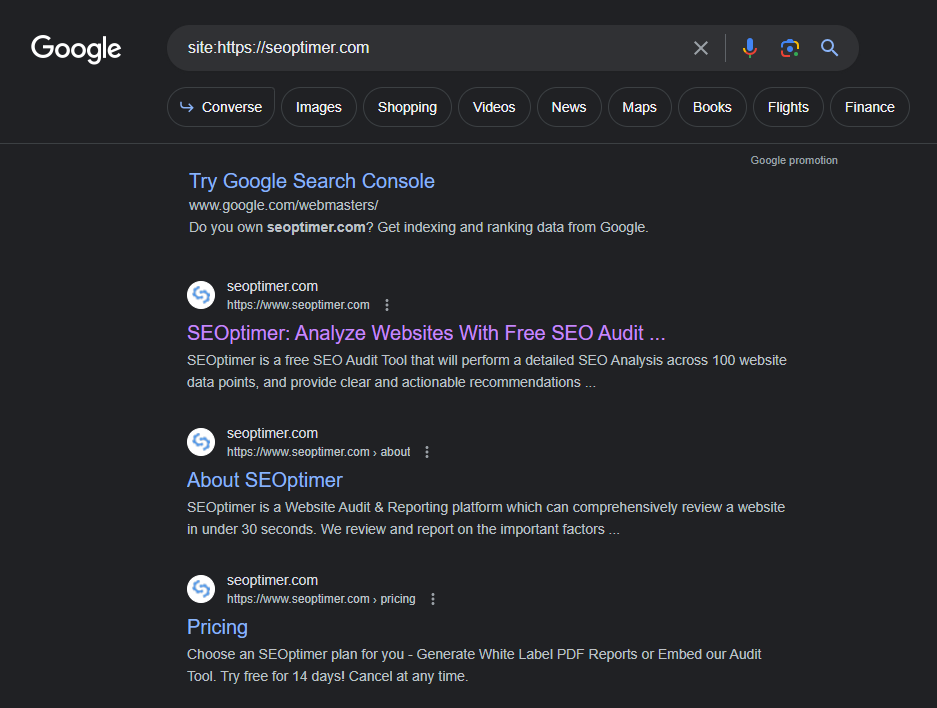
It takes a few days for a new link to get indexed. Results may vary depending on the age, authority and popularity of the website hosting that link.
Once the backlink has been detected and indexed, it will sit there for a while before the ball gets rolling.
In one Moz case study, a small sample size of 76 links was analyzed to determine how long before a new link can trigger changes in Google rankings. The results indicate that a single backlink takes an average of 10 weeks to push a page a rank higher on Google.
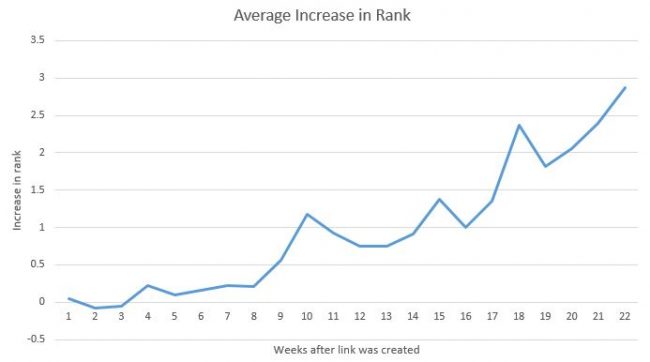
The Big Jump
The case study also reveals that pages in the top 10, where there’s intense competition, barely improve rankings in 22 weeks with one backlink.
Meanwhile, those languishing at the bottom (second page and below) benefit more from a single link, ending up several ranks higher after eight to nine weeks.
This is what I call the “Big Jump”—a phenomenon that makes it easier to jump from rank 80 to 26 than it is to climb from 6 to 1.
Take note that the study only used a small sample out of 200,000 pages, making it hard to draw a definite conclusion from its findings.
You can take the “Big Jump” as a positive sign that you’re on the right track. With patience and persistence, your page can eventually enter the coveted first page of search results.
Google’s ranking algorithm is now more intricate than ever; the journey to the top can be an “Uphill Climb.”
The Uphill Climb
In one case study, for instance, it’s revealed that the average top 10 ranking page is 2 to 3 years old.
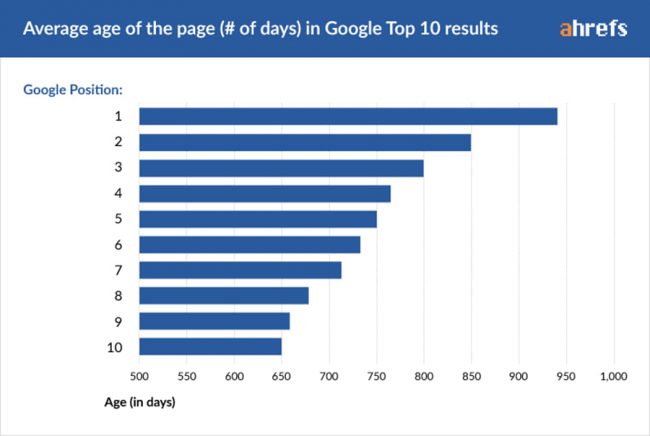
Simply put, it can take more than a year before a backlink propels a page to the first spot.
Factors That Affect How Long It Takes for Backlinks to Influence Rankings
Although you can’t appease an impatient client with a guaranteed time frame, you can leverage several link building factors to produce results at a quicker pace.
1. Domain Strength
Domain Strength is a ranking metric to predict how strong a website’s domain profile is.
Ranging from 1 to 100, this score can pretty much tell how well a site will rank in the Google search results.
For example, a page with a Domain Strength score of 77 has a better chance of ranking higher than a page with a Domain Strength of 22.
The same thing applies to backlinks.
Choosing backlinks from high-Domain Strength sites is logical for two reasons:
- Their pages are crawled more often. This makes it easier and faster for Google to index the backlinks pointing to your website.
- The high DA can spill over into your own website. Google bots will take the link as a sign that your page is trustworthy enough for a high-DA site to link to it.
What it means for your link building campaign:
The domain authority of both your website and the referring page can influence how fast you climb Google’s search engine results. Moz recommends “getting more links from other well-linked-to pages” to boost DA score.
To check your own site’s Domain Strength, you can go directly to the overview of your website’s profile in the SEOptimer Backlink Monitoring dashboard.
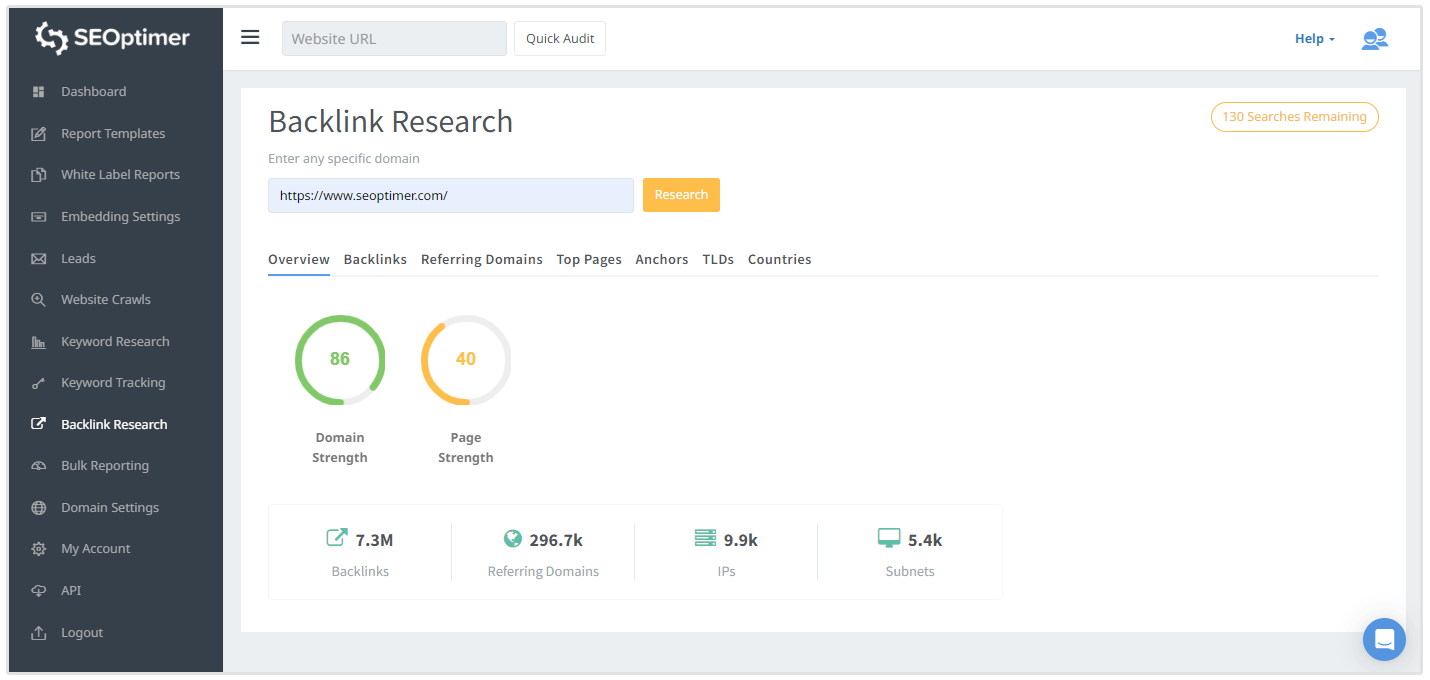
Once you’ve added your direct competitors to your SEOptimer Backlink Monitoring dashboard, you’ll always be able to see how they’re performing—in terms of domain authority and many more key areas—at a glance.
Note that Domain Strength isn’t static. A new website with a low score can improve its reputation as it adds more content and links within a few weeks or months.
Hence, you should never underestimate the power of new websites—they may just be diamonds in the rough. You’ll want to keep an eye on your close competitors, even if you think there’s no way they’ll catch up to your site’s authority.
2. Type of Backlinks
Not all links are created equal.
Good links can help propel your page to the top either directly or indirectly. There are also bad ones you should avoid if you don’t want to be slapped by Google’s unforgiving algorithm updates.
For starters, Google has laid out a list of link schemes that can get your site penalized. These links are relatively easier to acquire but will get you nowhere.
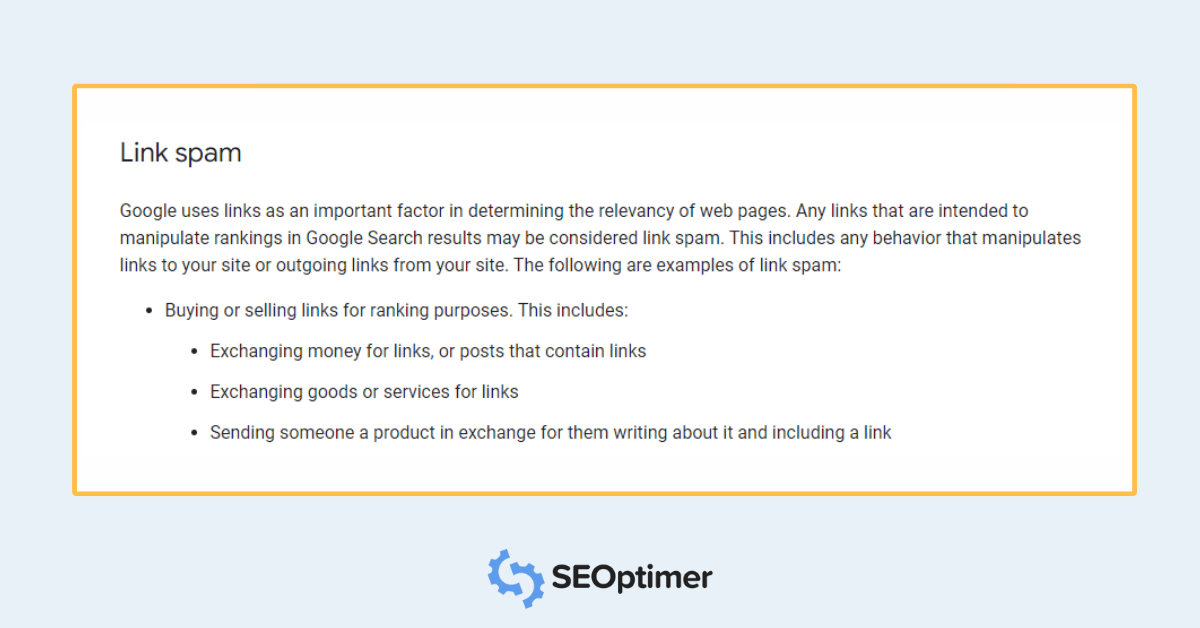
Long-term link building success relies on legitimate backlinks: Follow and nofollow.
Follow links are the holy grail that most online marketers are keeping their eyes on. They pass link juice to your page and have more power to improve rankings.
Nofollow links, on the other hand, proliferate on the internet. They have no SEO value and include links from social media, forums, blog comments, YouTube videos and popular publishers like BuzzFeed, Forbes and The New York Times.
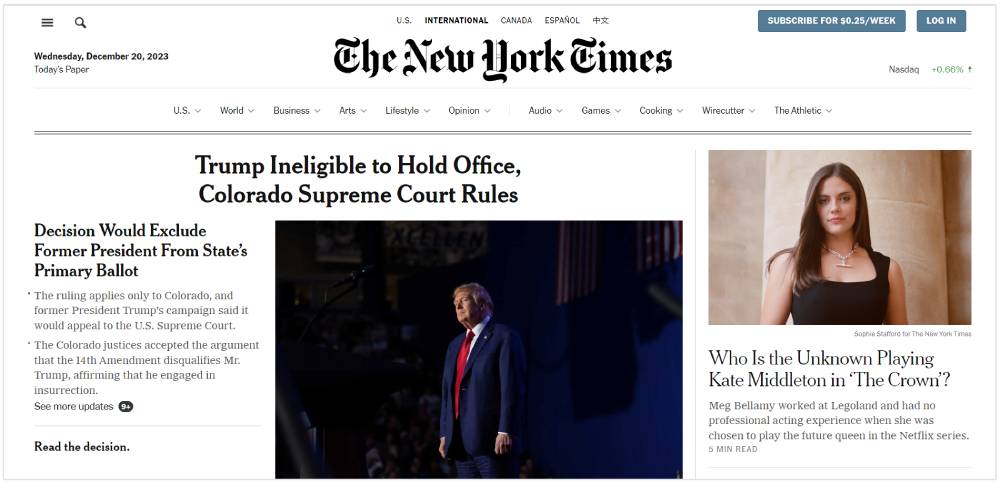
What it means for your link building campaign:
Don’t discount nofollow links just yet. Aside from providing variety in your link profile (Google will love you for that), nofollow links also open up opportunities for you to gain follow links.
Whether it’s found in an insightful tweet, expert advice on Quora or an in-depth blog comment, a nofollow link can make a difference. There’s always someone out there looking for a resource-loaded site to link to.
3. Trust and Brand Authority
Let’s admit it, established websites have a clear advantage over smaller, newer sites.
The older a site gets, the more backlinks it earns and the more trustworthy it appears in Google’s eyes. As a result, these authority sites can easily rank in the top 10 search results in a few days or weeks even with few or no backlinks.
For example, a one-year-old niche site ranking for a commercial keyword can easily be outranked by new and similar content from reputable product review sites like TopTenReviews or Wirecutter.
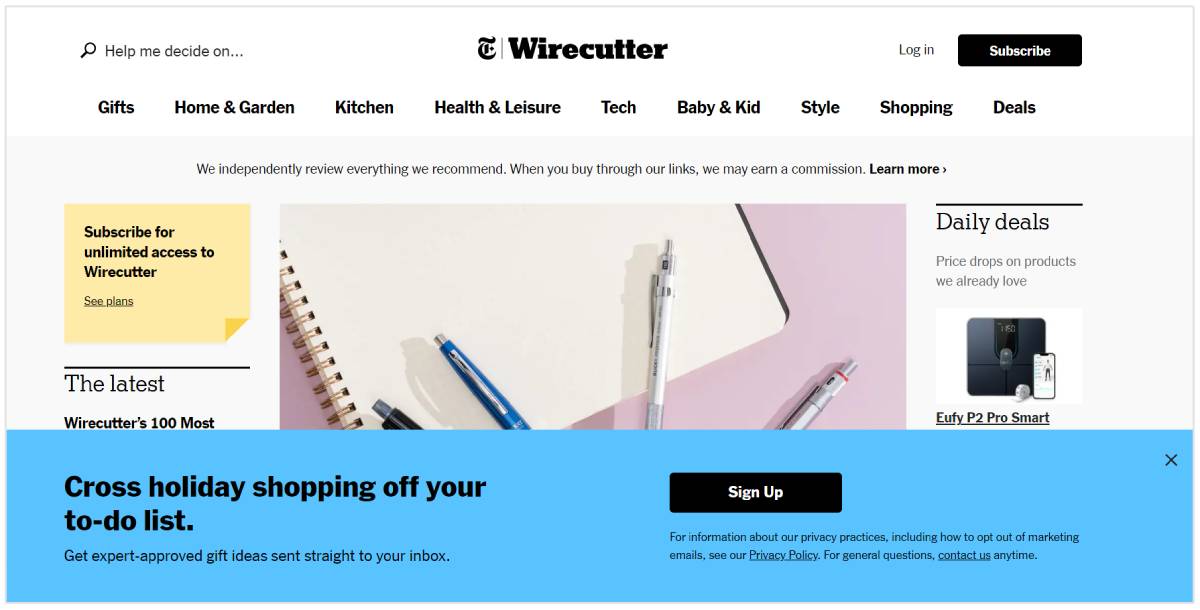
What it means for your link building campaign:
Before you back out believing that newcomers won’t stand a chance, remember that even the biggest blogs started from scratch.
While it won’t happen overnight, you can gradually build your reputation by piggybacking on the success of trusted high-authority sites.
4. Link Velocity
Link velocity is the rate at which you build backlinks to your blog.
The more backlinks you gain at once, the faster you will see results.
And how exactly can you gain numerous links almost simultaneously? You’ve guessed it: Viral content.
The good news is that virality isn’t exclusive to BuzzFeed listicles. Even boring niches like the legal industry can get a share of the pie and gain a sudden influx of links and search traffic.
However, it’s extremely hard to predict which content will take off. A sudden increase of inbound links through viral content requires a bit of luck and is therefore not always a reliable link building strategy.
What it means for your link building campaign:
Viral content seems to be the quickest solution for all your content marketing woes. But convincing thousands of eyeballs to read your content is more complex than you think.
In the book “Contagious: Why Things Catch On,” Wharton marketing professor Jonah Berger shares some tips that can help you turn your work into a viral link building machine:
- Make them look good — People share content that can show their social circles how cool, smart or cultured they are.
- Appeal to their emotions — There’s a reason why touching videos and controversial posts get shared a lot: They stir people’s emotions to the point of convincing them to get involved.
- Tell stories — Turn every article, no matter how dry or technical the subject is, into a conversation starter by incorporating anecdotes. Don’t just explain the product’s features; let your reader’s imagination run wild as they picture the product changing their lives.
There’s one caveat though: Building 500 or more links in the first 30 days can temporarily reduce the rankings of a brand new site.
However, as long as the backlinks are natural and come from high-quality and relevant sites, the page will eventually move up to higher spots after three months or so.
Unless you get the links through a viral article, you should aim for a slow-but-steady approach when building your initial backlinks.
Content marketing wizard Neil Patel recommends keeping link velocity at the following rate:

5. Keyword Competitiveness
Sizing up the competition is imperative if you want backlinks to move the needle faster.
In most cases, the search volume can indicate how hard it is to rank for a keyword. The higher the search volume of a keyword is, the more backlinks and time required for a page to earn a spot in the top 10 search results.
But the search volume only reveals how many people are using the keyword—not the motivation behind their searches.
Commercial keywords, for example, are generally tougher to rank for, regardless of search volume. The keyword “how to play a guitar” with 60,000 monthly searches may be relatively easier to rank for compared to “lawn mowing services orlando” with a mere 500 searches.
What it means for your link building campaign:
Keyword analysis is just the tip of the iceberg when analyzing the competition. It is on the battlefield (i.e., Google search results) where you will learn more how to attack your opponents.
Ideally, you want to see a number of low PA (page authority) and low DA (domain authority) pages ranking on the first page. Both PA and DA are search metrics developed by Moz to predict how well-linked and optimized a page is.
However, the data from Moz isn’t always foolproof.
There are pages that gained high scores in these metrics through black hat SEO. If this is the case, you have a better chance of outranking these pages by earning high-quality editorial and directory links.
6. Link Relevance
Building authority requires a laser-focus link building strategy.
It’s better to get 5 backlinks from highly relevant sites than from 20 off-topic niche blogs.
It makes sense if you think about the domino effect that a relevant content can bring to a brand.
For example, a guest post that’s in line with your niche will send new readers to your page. Since your content resonates with these readers, they’re less likely to leave the page, resulting in improved conversion and bounce rates.
SEO-wise, backlinks from relevant sites will help boost your authority. With consistency, Google will eventually take notice and prioritize your content over others that are all over the place.
What it means for your link building campaign:
Finding relevant websites that provide guest posting opportunities is relatively easier for some niches. In the case of boring industries, however, the process isn’t as smooth sailing.
But it doesn’t mean you won’t get the same success with an offbeat niche. Just ask this person who was able to drive 12 backlinks and a 15 percent increase in search traffic to a pest control website.
The secret? A “shoulder niche.”
In the above example, a simple round of mind-mapping helped link the pest control niche to the gardening niche. They’re two seemingly different industries, but they actually share one goal: Get rid of pests.
Armed with this knowledge of a common goal, the content marketer sent outreach emails to the top bloggers in the gardening niche. The result is nothing short of impressive, proving that creativity can go a long way in link building.
7. Anchor Text
Anchor text is the clickable word that links one page to another.
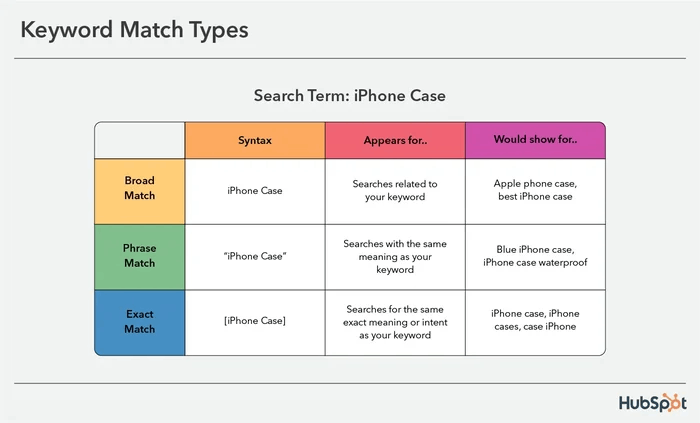
It takes different forms:
- Exact match anchor text (e.g., “best kitchen tools”)
- Partial match (e.g., “a list of the best kitchen tools”)
- Naked URL (the URL of the page as it would appear in the browser)
- Branded (the name of your brand/website)
- Generic words or phrases that don’t include any target keyword (e.g., “click here”)
Anchor texts used to hold much more power in ranking pages. In fact, in a 2008 paper by the Google founders, the anchor text was described as providing “more accurate descriptions of web pages than the pages themselves.”
Since it’s very easy to manipulate, anchor texts bearing exact match keywords soon proliferated on the web.
Then the 2012 Google Penguin update happened. It decimated virtually all websites that took part in link building schemes—including manipulated anchor texts.
But have anchor texts totally lost their influence?
Anchor text remains a powerful ranking factor. Both studies analyzed thousands of top pages ranking for medium to high competition keywords.
The results show that the top pages got to where they are due to a common factor: Backlinks containing exact and/or partial match keywords.
What it means for your link building campaign:
Anchor text remains an important factor. It makes a backlink more potent. It’s the language that tells Google what your site is about and what keyword you want it to rank for.
As a general rule of the thumb, you should keep exact match anchor texts to 1 to 2 percent of the overall backlink profile. Keep partial match anchor texts to only 30 percent of the overall backlink profile.
The remaining percentage should be comprised of all other forms of anchor text
Ensure that links aren’t from low-quality pages. Otherwise, the backlinks lose their force regardless of the anchor text you use.
SEOptimer can give you a hand with tasks related to anchor text. With this tool, you can clearly see the anchor for every single backlink you have. You can even sort and filter your backlink by anchor text.
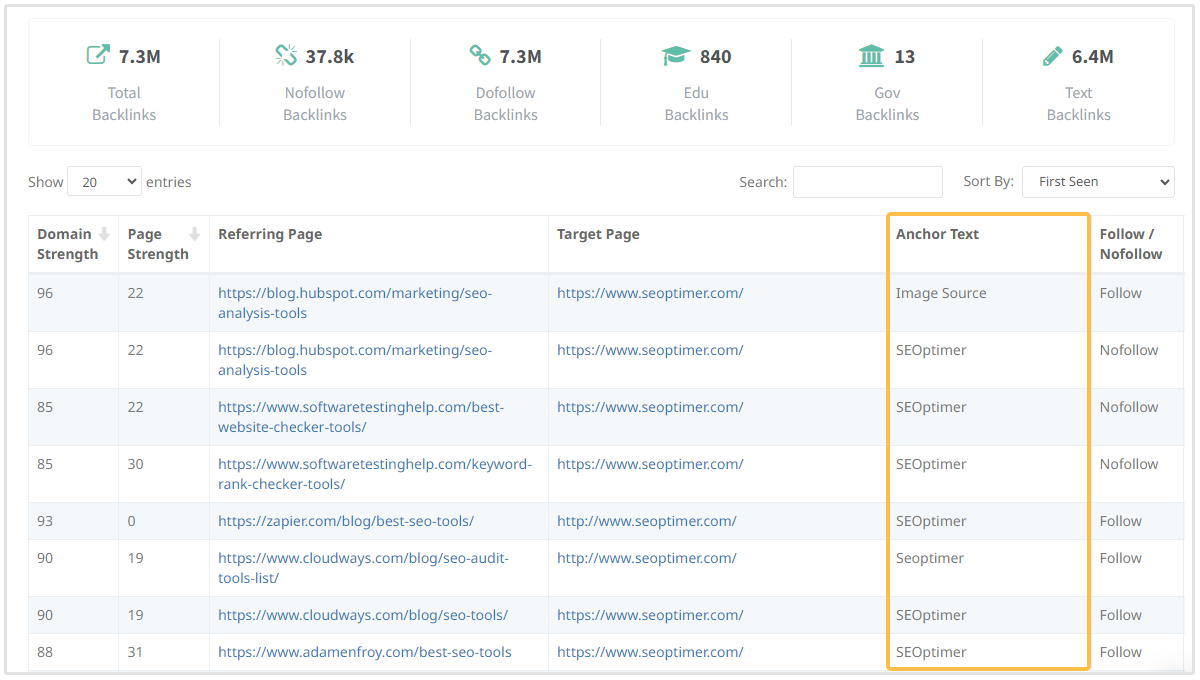
Whenever the anchor text is not ideal, you can consider reaching out to the site’s webmaster to change the anchor text.
Lastly, remember that anchor text is just one of many ranking factors; look at it as part of a bigger picture—not the big picture itself.
6 Ways to Leverage Backlinks for Faster, Better Results
1. Perform a Link Audit
A healthy link profile is what separates short-lived blogs from websites that stay on top of search results for years.
Having a strong list of backlinks is one thing. Keeping them up to par is another.
To ensure your backlinks won’t be removed or lose their power without your knowledge, you have to perform link audits.
A link audit is simply monitoring your backlinks. Since it’s impossible to track hundreds or thousands of links every day, I rely on online tools to do it for me.
My favorite tool for this purpose is SEOptimer, which I also use to track keyword rankings.
In addition to tracking your own backlinks, you can also check what your competitors are up to in terms of link building.
You can go directly to the SEOptimer dashboard to check your competitor’s backlinks. You’ll even get immediate notifications via email any time a competitor experiences a significant change.
With this feature, you have a chance to find weak spots and outrank your competition either by replicating the links or getting backlinks from better sources.
2. Disavow Spammy Links
You don’t want to throw your hard work away just because a sneaky competitor is sabotaging your links.
Negative SEO refers to the use of link schemes prohibited by Google to purposefully demote pages. It’s unethical, but it doesn’t stop some people from using it against their competitors.
Unless you remove these spammy and low-quality links from your link profile, they’ll keep dragging your page down.
Google warns that sending disavow reports should be a last resort. For best results, manually delete bad backlinks and only disavow those you can’t remove.
3. Work with the Right People
Link building can test the patience of even the most ambitious people.
It takes time to build relationships, brainstorm content and send outreach emails. If you’re not in this for the long-term, then SEO may not be the best marketing strategy for you.
The repercussions of a poorly-planned link building campaign are much more serious for big companies working with SEO agencies.
It can take up to four months just to find a link building agency and a few more months up to a year to implement link building strategies and wait for them to take effect.
In other words, working with the wrong people—whether it’s an agency or an in-house link builder—will not only drain your budget but also prolong the time before your backlinks influence rankings.
Perform due diligence when shopping for an agency, making sure you choose realistic timelines over false promises.
4. Create More “Guestographics”
In a nutshell, guestographics use the following formula:
Great Content + Targeted Outreach + Added Value = Links
Here, “great content” means creating an irresistible infographic and convincing relevant blogs to publish it.
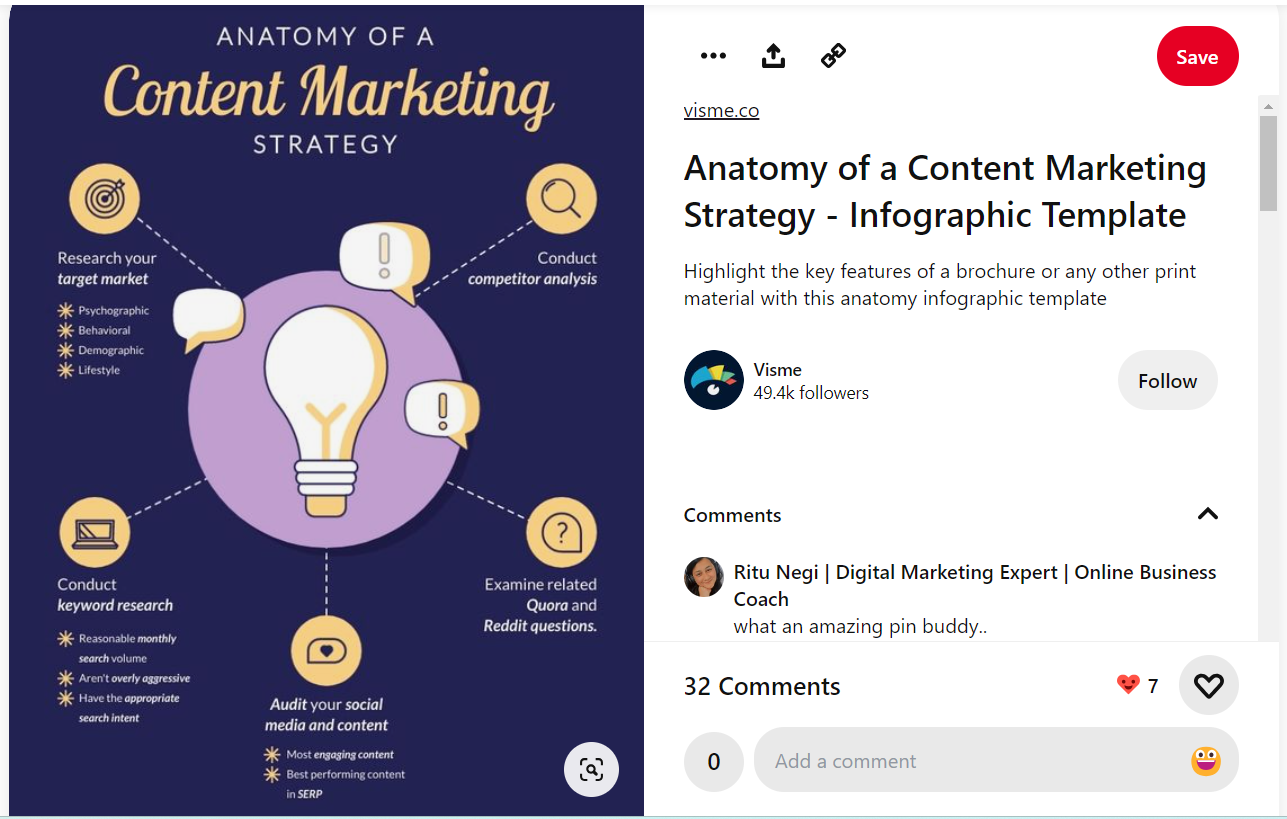
The trick, however, is in providing “added value.” You can do this by removing any barrier that could prevent your masterpiece from being published.
For example, you can offer to write an article about the infographic that’s customized to suit the blog’s audience.
With this strategy, you make it easier for the blog owners to publish your infographic, while giving yourself the freedom to use your preferred anchor text and insert the link within the article rather than the author bio where it has less SEO value.
The good news is that you can design the infographic on your own (thanks, Canva!) if you’re too broke or hesitant to pay a designer.
5. Focus on Quality Rather Than Quantity
It’s better to have 5 editorial links from established and branded websites than to earn 100 low-quality backlinks.
As the Moz case study has pointed out, links from high-Domain Strength sites are crawled more often and have a relatively more positive impact on search rankings than backlinks from low-Domain Strength sites.
Investing in relevant, engaging and comprehensive guest posts are also great for branding. They leave a positive impression with your readers, attract more links and position your company or website as an online authority.
6. Keep Track of Your Links
If you’re serious about getting SEO results and keeping track of them, SEOptimer is an indispensable tool—it would definitely be worth trying it out for the free trial, at the very least.
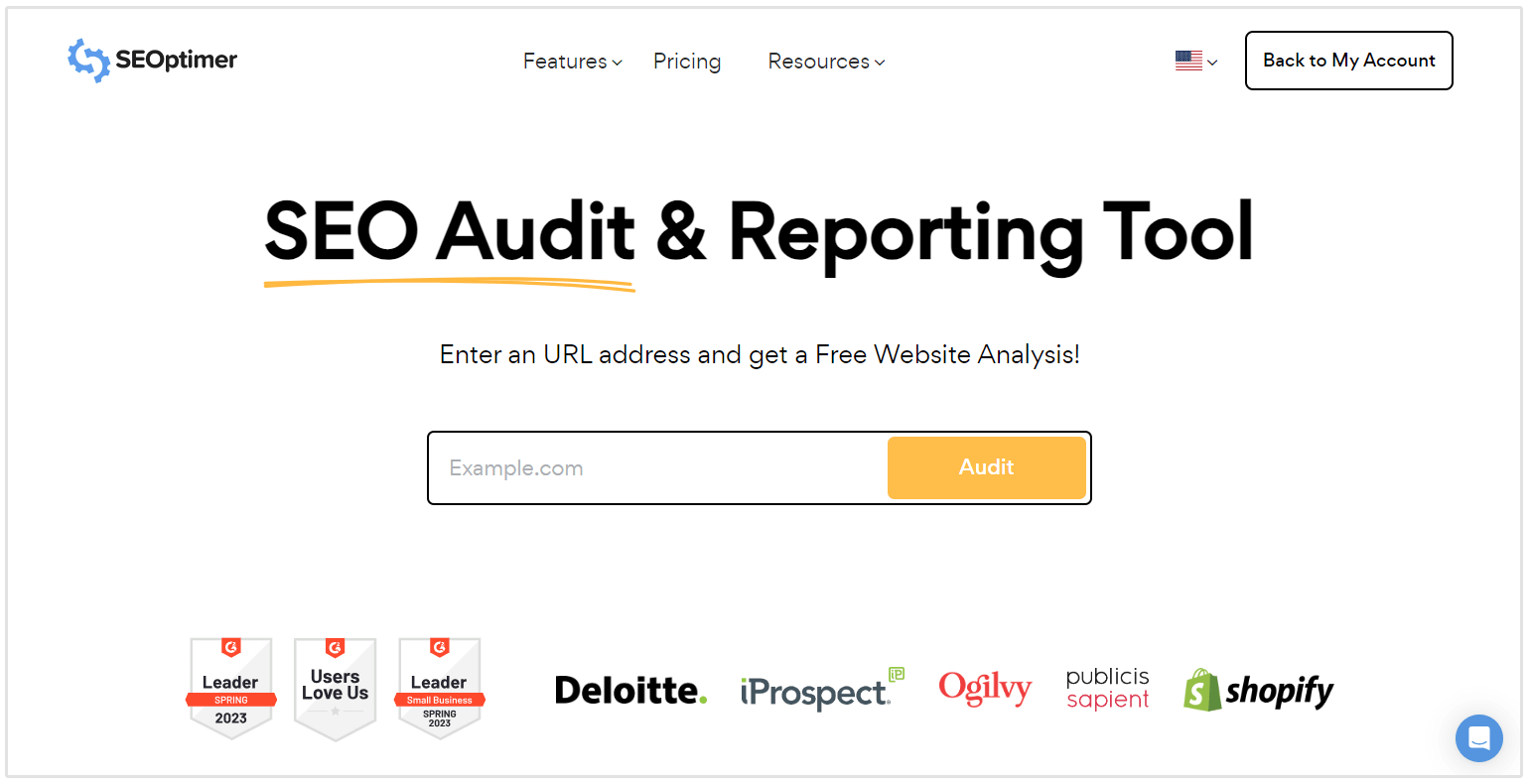
After all, if you’re focused on link building, you’re going to want to see:
- when and where new backlinks appear
- when and where existing backlinks have disappeared
- new opportunities for link building outreach
- competitor backlinks that you can snatch up
SEOptimer can do all of these things and much more—it will even track your keyword rankings so you can see how the backlinks are affecting those precious SERPs.
Although the effects of different backlinks may vary, one thing is clear.
Link building can only get you so far.
The quality of your content or services is what will sustain you in the long run.
Focus on quality, and the links will come more easily.










